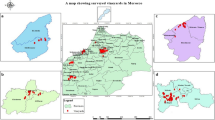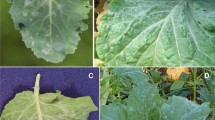Abstract
Esca is one of the most important grapevine trunk diseases, and it can induce severe decline. In the past, the disease occurred mostly on mature vines, but today it is also present in young vineyards. The aim of this study was to investigate the incidence of esca in young (< 7 years old) and mature (> 11 years old) vineyards on cvs Montepulciano, Sangiovese, Verdicchio and Passerina located in the main viticultural areas of the Marche Region, central-eastern Italy. The average incidence of diseased plants was higher in mature (32.6%) than young (5.2%) vineyards, and Verdicchio and Passerina appeared to be the most sensitive among the cultivars considered, followed by Sangiovese and Montepulciano. The analysis of the spatial spread of esca carried out in two mature vineyards on cv. Verdicchio and a young vineyard on cv. Sangiovese showed a fluctuation in the numbers of infected plants over the three years of observation. The fungi associated with symptomatic plants were detected by classical and molecular tools. Isolation on agar media yielded colonies of Phaeomoniella chlamydospora (Pch), Botryosphaeria spp. (Bot), Fomitiporia mediterranea (Fomed) and, sporadically, Phaeoacremonium aleophilum (Pal). In samples from young plants, Bot and Pch were recurrent, while Pch and Fomed were found in mature vines and old rootstocks. Molecular detection with specific primer pairs for Pch, Pal, Fomed, and B. dothidea confirmed the data obtained using classical tools, and in some cases it was more sensitive. This study thus provides a further contribution to the association between causal agents and esca symptoms, and it confirms the importance of molecular tools for a sensitive detection of associated pathogens, which can also be present in propagative materials.





Similar content being viewed by others
References
Abbatecola, A., Pollastro, S., Pichierri, A., & Faretra, F. (2006). Survey on the presence of Phaeomoniella chlamydospora in grapevine rootstocks. Journal of Plant Pathology, 88, S31.
Aroca, A., Garcia-Figueres, F., Bracamonte, L., Luque, J., & Raposo, R. (2006). A survey of trunk disease pathogens within rootstocks of grapevines in Spain. European Journal of Plant Pathology, 115, 195–202. doi:10.1007/s10658-006-9008-5.
Bertelli, E., Mugnai, L., & Surico, G. (1998). Presence of Phaeoacremonium chlamydosporum in apparently healthy rooted grapevine cuttings. Phytopathologia Mediterranea, 37, 79–82.
Borgo, M., Bellotto, D., Dal Cortivo, G. L., Zanzotto, A., Tosi, E., & Marchesini, E. (2008). Sensibilità varietale al mal dell’esca della vite nel Veneto. Proceedings of the symposium “Giornate Fitopatologiche”, 2, 223–230. Cervia (RA), Italy.
Bradshaw, R. E., Duan, G., & Long, P. G. (2005). Transformation of fungal grapevine trunk disease pathogens with the green fluorescent protein gene. Phytopathologia Mediterranea, 44, 162–168.
Bruno, G., & Sparapano, L. (2006). Effects of three esca-associated fungi on Vitis vinifera L.: II. Characterization of biomolecules in xylem sap and leaves of healthy and diseased vines. Physiological and Molecular Plant Pathology, 69, 195–208. doi:10.1016/j.pmpp.2007.04.007.
Calzarano, F., & Di Marco, S. (2007). Wood discoloration and decay in grapevines with esca proper and their relationship with foliar symptoms. Phytopathologia Mediterranea, 46, 96–101.
Cortesi, P., Fisher, M., & Milgroom, M. G. (2000). Population diversity of Fomitiporia punctata from grapevine and spread of esca disease. IOBC/WPRS Bulletin, 23, 71–74.
Corti, G., Agnelli, A., Coniglio, R., Ricci, F., & Panichi, M. (2004). Suolo e mal dell’esca della vite: il punto dall’inizio delle indagini. L’Informatore Agrario, 12, 79–83.
Di Marco, S., Mazzullo, A., Calzarano, F., & Cesari, A. (2000). The control of esca: status and perspectives. Phytopathologia Mediterranea, 39, 232–240.
Doyle, J. J., & Doyle, J. L. (1990). Isolation of plant DNA from fresh tissue. Focus (San Francisco, Calif.), 12, 13–15.
Edwards, J., & Pascoe, I. G. (2004). Occurrence of Phaeomoniella chlamydospora and Phaeoacremonium aleophilum associated with Petri disease and esca in Australian grapevines. Australasian Plant Pathology, 33, 273–279. doi:10.1071/AP04016.
Edwards, J., Constable, F., Wiechel, T., & Salib, S. (2007). Comparison of the molecular tests–single PCR, nested PCR and quantitative PCR (SYBR®Green and TaqMan®)–for detection of Phaeomoniella chlamydospora during grapevine nursery propagation. Phytopathologia Mediterranea, 46, 58–62.
Fischer, M. (2006). Biodiversity and geographic distribution of basidiomycetes causing esca-associated white rot in grapevine: a worldwide perspective. Phytopathologia Mediterranea, 45, S30–S42.
Fourie, P. H., & Halleen, F. (2006). Chemical and biological protection of grapevine propagation material from trunk disease pathogens. European Journal of Plant Pathology, 116, 255–265. doi:10.1007/s10658-006-9057-9.
Frisullo, S., Caponero, A., & Cirulli, M. (1992). Ricerche sulle cause dell’”imbrunimento del legno” delle barbatelle di vite. Petria, 2, 171–182.
Gimenez-Jaime, A., Aroca, A., Raposo, R., Garcia–Jimenez, J., & Armengol, J. (2006). Occurrence of fungal pathogens associated with grapevine nurseries and the decline of young vines in Spain. Journal of Phytopathology, 154, 598–602. doi:10.1111/j.1439-0434.2006.01153.x.
Graniti, A., Surico, G., & Mugnai, L. (2000). Esca of grapevine: a disease complex or a complex of diseases? Phytopathologia Mediterranea, 39, 16–20.
Halleen, F., Crous, P. W., & Petrini, O. (2003). Fungi associated with healthy grapevine cuttings in nursery, with special reference to pathogens involved in the decline of young vines. Australasian Plant Pathology, 32, 47–52. doi:10.1071/AP02062.
Landi, L., & Romanazzi, G. (2006). Transformation of Phaeomoniella chlamydospora with the synthetic green fluorescent protein (sGFP) gene. Journal of Plant Pathology, 88, S47.
Larignon, P., & Dubos, B. (1997). Fungi associated with esca disease in grapevine. European Journal of Plant Pathology, 103, 147–157. doi:10.1023/A:1008638409410.
Lazizzera, C., Frisullo, S., Alves, A., & Phillips, A. J. L. (2008). Morphology, phylogeny and pathogenicity of Botryosphaeria and Neofusicoccum species associated with drupe rot of olives in southern Italy. Plant Pathology, 57, 948–956. doi:10.1111/j.1365-3059.2008.01842.x.
Ma, Z., Luo, Y., & Michailides, T. J. (2003). Nested PCR Assays for Detection of Monilinia fructicola in Stone Fruit Orchards and Botryosphaeria dothidea from Pistachios in California. Journal of Phytopathology, 151, 312–322. doi:10.1046/j.1439-0434.2003.00725.x.
Marchi, G. (2001). Susceptibility to esca of various grapevine (Vitis vinifera) cultivars grafted on different rootstocks in a vineyard in the province of Siena (Italy). Phytopathologia Mediterranea, 40, 27–36.
Marchi, G., Peduto, F., Mugnai, L., Di Marco, S., Calzarano, F., & Surico, G. (2006). Some observations on the relationship of manifest and hidden esca to rainfall. Phytopathologia Mediterranea, 45, S117–S126.
Martos, S., Andolfi, A., Luque, J., Mugnai, L., Surico, G., & Evidente, A. (2008). Production of phytotoxic metabolites by five species of Botryosphaeriaceae causing decline on grapevines, with special interest in the species Neofusicoccum luteum and N. parvum. European Journal of Plant Pathology, 121, 451–461. doi:10.1007/s10658-007-9263-0.
Michelon, L., Pellegrini, C., & Pertot, I. (2007). Il mal dell’esca della vite. Safe Crop Center Istituto Agrario San Michele all’Adige p. 73.
Mugnai, L., Graniti, A., & Surico, G. (1999). Esca (Black Measles) and brown wood-streaking: two old and elusive diseases of grapevines. Plant Disease, 83, 404–418. doi:10.1094/PDIS.1999.83.5.404.
Overton, B. E., Stewart, E. L., **nshun, Q., Wenner, N. G., & Christ, B. J. (2004). Qualitative real-time PCR SYBR Green detection of Petri disease fungi. Phytopathologia Mediterranea, 43, 403–410.
Pollastro, S., Dongiovanni, C., Abbatecola, A., & Faretra, F. (2000). Observations on the fungi associated with esca and on spatial distribution of esca symptomatic plants in Apulian (Italy) vineyards. Phytopathologia Mediterranea, 39, 206–210.
Rego, C., Oliveira, H., Carvalho, A., & Phillips, A. (2000). Involvement of Phaeoacremonium spp. and Cylindrocarpon destructans with grapevine decline in Portugal. Phytopathologia Mediterranea, 39, 76–79.
Retief, E., McLeod, A., & Fourie, P. H. (2006). Potential inoculum sources of Phaeomoniella chlamydospora in South African grapevine nurseries. European Journal of Plant Pathology, 115, 331–339. doi:10.1007/s10658-006-9025-4.
Ridgway, H. J., Sleight, B. E., & Stewart, A. (2002). Molecular evidence for the presence of Phaeomoniella chlamydospora in New Zealand nurseries, and its detection in rootstock mother vines using species-specific PCR. Australasian Plant Pathology, 31, 267–271. doi:10.1071/AP02021.
Romanazzi, G., Murolo, S., Pizzichini, L., & Nardi, S. (2006). Grapevine esca disease in Marche region: first results. Proceedings of the symposium “Giornate Fitopatologiche”, 2, 289–290. Riccione (RN), Italy.
Rumbos, I., & Rumbou, A. (2001). Fungi associated with esca and young grapevine decline in Greece. Phytopathologia Mediterranea, 40, S330–S335.
Scheck, H., Vasquez, S., Fogle, D., & Gubler, W. D. (1998). Grape growers report losses to black foot and grapevine decline. California Agriculture, 52, 19–23.
Serra, S., Borgo, M., & Zanzotto, A. (2000). Investigation into the presence of fungi associated with esca of young vines. Phytopathologia Mediterranea, 39, 21–25.
Sidoti, A., Buonocore, E., Serges, T., & Mugnai, L. (2000). Decline of young grapevines associated with Phaeoacremonium chlamydosporum in Sicily (Italy). Phytopathologia Mediterranea, 39, 87–91.
Surico, G., Marchi, G., Braccini, P., & Mugnai, L. (2000). Epidemiology of esca in some vineyards in Tuscany (Italy). Phytopathologia Mediterranea, 39, 190–205.
Surico, G., Bandinelli, R., Braccini, P., Di Marco, S., Marchi, G., Mugnai, L., et al. (2004). On the factors that may have influenced the esca epidemic in Tuscany in the eighties. Phytopathologia Mediterranea, 43, 136–143.
Surico, G., Di Marco, S., Mugnai, L., & Marchi, G. (2006). La lotta contro il mal dell'esca: ancora buio ma con qualche promettente schiarita. Informatore Fitopatologico, 4, 18–25.
Tegli, S., Santelli, E., Bertelli, E., & Surico, G. (2000). Genetic variation with Phaeoacremonium aleophilum and Phaeomoniella chlamydospora in Italy. Phytopathologia Mediterranea, 39, 125–133.
Úrbez-Torres, J. R., Leavitt, G. M., Voegel, T. M., & Gubler, W. D. (2006). Identification and distribution of Botryosphaeria spp. associated with grapevine cankers in California. Plant Disease, 90, 1490–1503. doi:10.1094/PD-90-1490.
Zanzotto, A., Autiero, F., Bellotto, D., Dal Cortivo, G., Lucchetta, G., & Borgo, M. (2007). Occurrence of Phaeoacremonium spp. and Phaeomoniella chlamydospora in grape propagation materials and young grapevines. European Journal of Plant Pathology, 119, 183–192. doi:10.1007/s10658-007-9160-6.
Acknowledgements
The research study was commissioned from ARSIA-Toscana (Regional Agency for Development and Innovation in Agriculture and Forest) by fourteen administrative Regions and one autonomous province, and financed with funds provided by the “Ministero per le Politiche Agricole e Forestali” (Ministry for Agriculture and Forestry Policy, Italy) to implement the inter-Regional Project “Grapevine esca: research and experiment in the nursery and in the field for prevention and cure.” Thanks are also due to Prof. F. Faretra, University of Bari, who kindly provided the primers for the detection of Phaeomoniella chlamydospora.
Author information
Authors and Affiliations
Corresponding author
Rights and permissions
About this article
Cite this article
Romanazzi, G., Murolo, S., Pizzichini, L. et al. Esca in young and mature vineyards, and molecular diagnosis of the associated fungi. Eur J Plant Pathol 125, 277–290 (2009). https://doi.org/10.1007/s10658-009-9481-8
Received:
Accepted:
Published:
Issue Date:
DOI: https://doi.org/10.1007/s10658-009-9481-8




